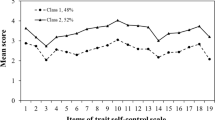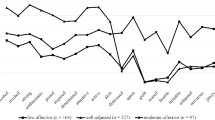Abstract
The aim of the present study was to explore how the number of recalled life events (positive and negative) predicts psychological well-being (PWB) and how PWB predicts life satisfaction (LS). In addition, participants were categorized into one of four different affective temperaments (self-actualizing, high affective, low affective, and self-destructive). One hundred and thirty-five high school students participated in completing the SWLS (LS), PWB (short-version), PANAS (to create affective temperaments), and the life events recollection task. Results indicated that adolescents with high positive affect also had high PWB; adolescents with low affective profiles also had high PWB. Positive and negative life events predicted PWB for self-destructive temperaments, whereas positive life events predicted PWB for low affective temperaments. PWB predicted LS for all temperaments except the self-actualizing group. In conclusion, the temperament combinations may allow the individual to achieve PWB and LS. Even more importantly, selfacceptance may foster LS regardless of temperament and may have more impact on LS than life events.
Similar content being viewed by others
References
Abramson, L., & Needles, D. J. (1990). Positive life events, attributional style, and hopefulness: Testing a model of recovery from depression. Journal of Abnormal Psychology, 99, 156–165.
Christensen, L. B. (2004). Experimental methodology. Boston: Pearson Education.
Clarke, P. J., Marshall, V. M., Ryff, C. D., & Wheaton, B. (2001). Measuring psychological well-being in the Canadian study of health and aging. International Psychogeriatrics, 13, 79–90.
Cloninger, C. R. (2004). Feeling good: The science of well-being. New York: Oxford University Press.
Cloninger, C. R. (2006). Fostering spirituality and well-being in clinical practice. Psychiatric Annals, 36, 1–6.
Deci, E. L., & Flaste, R. (1996). Why we do what we do: Understanding self-motivation. London: Penguin Books.
Diener, E., & Diener, C. (1996). Most people are happy. Psychological Science, 7, 181–185.
Diener, E., & Lucas, R. E. (1999). Personality and subjective well-being. In D. Kahneman, E. Diener, & N. Schwarz (Eds.), Well-being: The foundations of hedonic psychology (pp. 213–229). New York: Russell Sage Found.
Diener, E., & Seligman, M. E. P. (2002). Very happy people. Psychological Science, 13, 81–84.
Diener, E., Colvin, C. R., Pavot, W. G., & Allman, A. (1991). The psychic costs of intense positive affect. Journal of Personality and Social Psychology, 61, 492–503.
Diener, E., Oishi, S., & Lucas, R. E. (2003). Personality, culture, and subjective well-being: Emotional and cognitive evaluations of life. Annual Review of Psychology, 54, 403–425.
Diener, E., Lucas, R. E., & Scollon, C. N. (2006). Beyond the hedonic treadmill. American Psychologist, 61, 305–314.
Fogle, L. M., Huebner, E. S., & Laughlin, J. E. (2002). The relationship between temperament and life satisfaction in early adolescence: Cognitive and behavioral mediation models. Journal of Happiness Studies, 3, 373–392.
Fredrickson, B. L. (2006). The broaden-and-build theory of positive emotions. In M. Csikszentmihalyi & I. S. Csikszentmihalyi (Eds.), A life worth living. Contributions to positive psychology (pp. 85–103). New York: Oxford University Press.
Fredrickson, B. L., & Branigan, C. (2005). Positive emotions broaden the scope of attention and thought-action repertoires. Cognition and Emotion, 19, 313–332.
Fujita, F., & Diener, E. (2005). Life satisfaction set point: Stability and change. Journal of Personality and Social Psychology, 88, 158–164.
Funk, B. A. III, Huebner, E. S., & Valois, R. F. (2006). Reliability and validity of a brief life satisfaction scale with a high school sample. Journal of Happiness Studies, 7, 41–54.
Garcia, D., & Siddiqui, A. (2008). Adolescents’ life satisfaction: Temperamental dispositions, interpretation of events and memory. Manuscript submitted for publication.
González, M., Casas, F., & Coenders, G. (2007). A complexity approach to psychological well-being in adolescence: Major strengths and methodological issues. Social Indicators Research, 80, 267–295.
Gunderson, J. G., Triebwasser, J., Phillips, K. A., & Sullivan, C. N. (1999). Personality and vulnerability to affective disorders. In C. R. Cloninger (Ed.), Personality and psychopathology (pp. 3–32). New York: American Psychiatric Publishing.
Hepburn, L., & Eysenck, M. W. (1989). Personality, average mood and mood variability. Personality and Individual Differences, 10, 975–983.
Kim-Prieto, C., Diener, E., Tamir, M., Scollon, C., & Diener, M. (2005). Integrating the diverse definitions of happiness: A time-sequential framework of subjective well-being. Journal of Happiness Studies, 6, 261–300.
Larsen, R. J., & Ketelaar, T. (1991). Personality and susceptibility to positive and negative emotional states. Journal of Personality and Social Psychology, 61, 132–140.
Lykken, D., & Tellegen, A. (1996). Happiness is a stochastic phenomenon. Psychological Science, 7, 186–189.
Lyubomirsky, S., King, L., & Diener, E. (2005). The benefits of frequent positive affect: Does happiness lead to success? Psychological Bulletin, 6, 803–855.
McCullough, G., Huebner, E. S., & Laughlin, J. E. (2000). Life events, self-concept, and adolescents’ positive subjective well-being. Psychology in the Schools, 37, 281–290.
Neto, F. (1993). Satisfaction with life among Portuguese adolescents. Journal of Youth and Adolescence, 22, 125–134.
Norlander, T., Bood, S.-Å., & Archer, T. (2002). Performance during stress: Affective personality age, and regularity of physical exercise. Social Behavior and Personality, 30, 495–508.
Norlander, T., Johansson, Å., & Bood, S.-Å. (2005). The affective personality: Its relation to quality of sleep, well-being and stress. Social Behavior and Personality, 33, 709–722.
Pavot, W., & Diener, E. (1993). Review of the satisfaction with life scale. Psychological Assessment, 2, 164–172.
Ryan, R. M., & Deci, E. L. (2001). On happiness and human potentials: A review of research on hedonic and eudaimonic well-being. Annual Review of Psychology, 52, 141–166.
Ryff, C. D. (1989). Happiness is everything, or is it? Explorations on the meaning of psychological well-being. Journal of Personality and Social Psychology, 57, 1069–1081.
Ryff, C. D. (1995). Psychological well-being in adult life. Current Directions in Psychological Science, 4, 99–104.
Ryff, C. D., & Keyes, C. L. M. (1995). The structure of psychological well-being revisited. Journal of Personality and Social Psychology, 69, 719–727.
Ryff, C. D., & Singer, B. (1998). The contours of positive human health. Psychological Inquiry, 9, 2–28.
Schimmack, U. (2007). Methodological issues in the assessment of the affective component of subjective well-being. In A. D. Ong & M. H. M. Van Dulmen (Eds.), Oxford handbook of methods in positive psychology (pp. 96–110). New York: Oxford University Press.
Seidlitz, L., & Diener, E. (1993). Memory for positive versus negative life events: Theories for the differences between happy and unhappy persons. Journal of Personality and Social Psychology, 64, 654–664.
Sheldon, M. K., & Lyubomirsky, S. (2006). Achieving sustainable gains in happiness: Change your actions, not your circumstances. Journal of Happiness Studies, 7, 55–86.
Tellegen, A. (1993). Folk concepts and psychological concepts of personality and personality disorder. Psychological Inquiry, 4, 122–130.
Tugade, M. M., & Fredrickson, B. L. (2004). Resilient individuals use positive emotions to bounce back from negative emotional arousal. Journal of Personality and Social Psychology, 86, 320–333.
Urry, H. L., Nitschke, J. B., Dolski, I., Jackson, D. C., Dalton, K. M., Mueller, C. J., et al. (2004). Making life worth living: Neural correlates of well-being. Psychological Science, 15, 367–372.
Walker, W. R., Skowronski, J. J., & Thompson, C. P. (2003). Life is pleasant—and memory helps to keep it that way! Review of General Psychology, 7, 203–210.
Waterman, A. S. (1993). Two conceptions of happiness: Contrasts of personal expressiveness (eudaimonia) and hedonic enjoyment. Journal of Personality and Social Psychology, 64, 678–691.
Watson, D., & Clark, L. A. (1994). The PANAS-X: Manual for the positive and negative affect schedule—expanded form. Boise: University of Iowa Press.
Watson, D., Clark, L. A., & Tellegen, A. (1988). Development and validation of brief measures of positive and negative affect: The PANAS scale. Journal of Personality and Social Psychology, 54, 1063–1070.
Windle, M., & Windle, R. C. (2006). Adolescent temperament and lifetime psychiatric and substance abuse disorders assessed in young adulthood. Personality and Individual Differences, 41, 15–25.
Acknowlegments
This research was partly supported by the research fund of humanities and social sciences faculty at Växjö Universitet. The authors wish to thank Patricia Rosenberg, Olga Lindström, Johanna Ekberg, Britt Lilja, Caj Eriksson and the participants for their help facilitating this study. Appreciation is also directed to reviewers who helped improve the manuscript.
Author information
Authors and Affiliations
Corresponding author
Rights and permissions
About this article
Cite this article
Garcia, D., Siddiqui, A. Adolescents’ Psychological Well-Being and Memory for Life Events: Influences on Life Satisfaction with Respect to Temperamental Dispositions. J Happiness Stud 10, 407–419 (2009). https://doi.org/10.1007/s10902-008-9096-3
Received:
Accepted:
Published:
Issue Date:
DOI: https://doi.org/10.1007/s10902-008-9096-3




